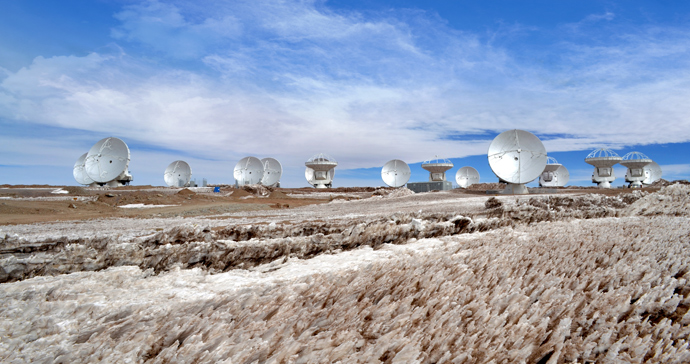Window into Big Bang: World’s largest ground-based telescope can see the birth of stars (PHOTOS)

Detailed visions of star and planet formation, hidden from the eyes of modern optics, will be soon shown by the ground breaking ALMA radio telescope unveiled on Wednesday. Scientists say it will be a game changer in studying the origins of our universe.
ALMA stands for Atacama Large Millimeter/submillimeter Array, and it is the largest ground-based astronomy project. It’s the most expensive one too, with construction costs going up to $1.3 billion. ALMA’s been devised and built by the joint efforts of scientists from European, East Asian and North American countries for more than a decade.
It consists of 66 huge antennas and a supercomputer installed in a 10-mile (16 km) diameter area on a high-altitude plateau in Chile. A lower-ground operating support facility is connected to the complex by some 15 km of cables.

Upon completion, the cutting edge telescope will become the most powerful in the world, with resolution ten times higher than the Very Large Array (VLA) and five times finer than the Hubble Space Telescope.
Scientists compared the array’s working principle to how we
perceive sound by two ears. Each of ALMA’s antennas, ranging from 7
to 12 meters in diameter, gathers radio waves from space, and their
combined result is processed through the supercomputer.
Height is one of the key factors of ALMA’s incredible power, as water vapor absorbs radio waves nearer to sea level and obscures observations. This is the reason the $1.3 billion complex had to be mounted at an altitude of 5,000 meters amidst the arid Chilean desert, with construction workers having to use supplemental oxygen, and the science team having to operate in the 2,900 meters high support facility.
But for astronomers these are negligible costs when compared to the perspectives, which the ALMA project is said to be opening.

“The scientific community wants to use ALMA in its research on star formation, the birth of planets and not just what is happening in our solar system, but also on how the system was created after the Big Bang,” ALMA director Thijs de Graaw said.
According to Big Bang theory, the origin of our universe occurred about 13.77 billion years ago.
“It is a revolution in the history of the universe in the realm of millimetric and sub-millimetric waves, which can look through clouds of dust and focus on the formation of stars themselves. Telescopes cannot see what is happening inside these clouds. With ALMA, we can. And that is like opening a new window,” he added.
“It will have a view of the universe that we can’t even imagine even now,” Wolfgang Wild, ESO’s European ALMA project manager also told SPACE.com.

Not only will ALMA bring about a new picture of the universe’s formation, it could also make a breakthrough in the study of alien worlds.
Astronomers would be able to detect the effects of young planets the size of Earth, SPACE.com quoted James Ulvestad, director of the US National Science Foundation’s astronomical sciences division.
“ALMA already has seen dust rings around stars that are very
narrow, and by modeling... you can infer the dust ring has planets
inside and outside the ring. Even though you can’t see the planet,
you can see the effects of the planet. That would be the
predominant way that ALMA will study extra-solar planets,”
Ulvestad explained.


















